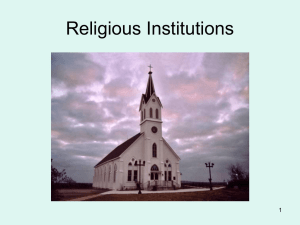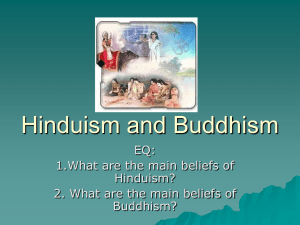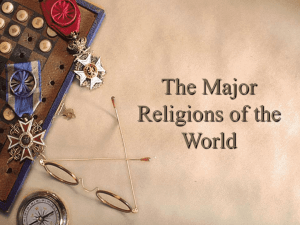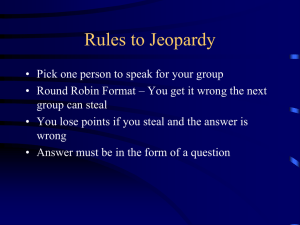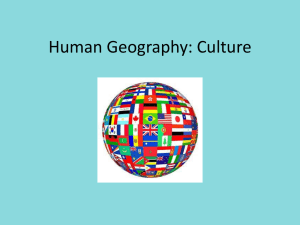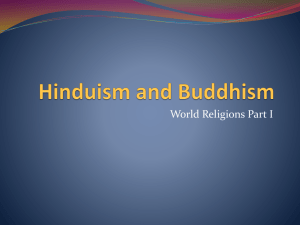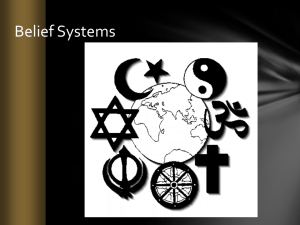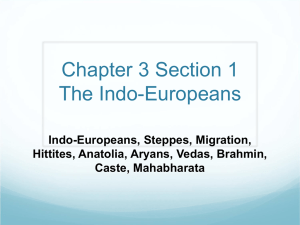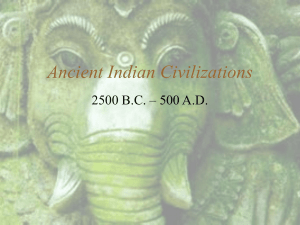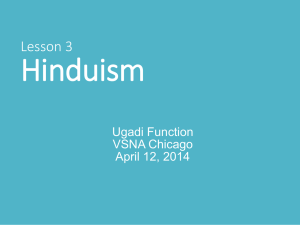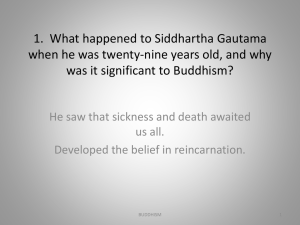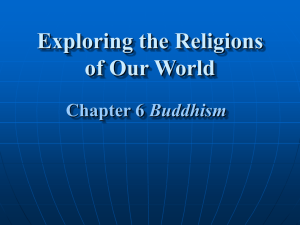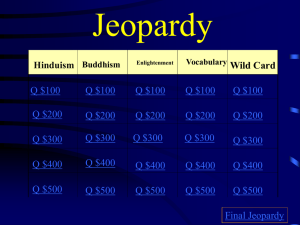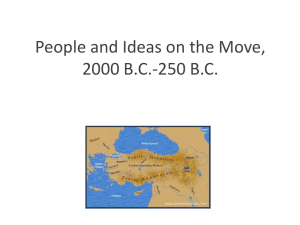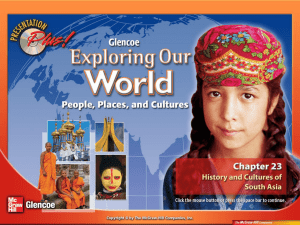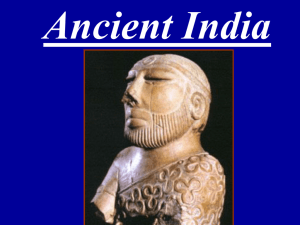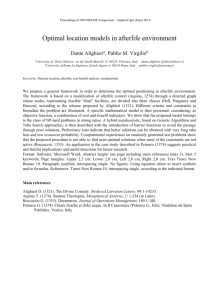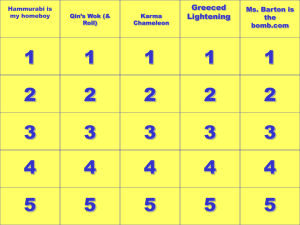Major Religions in WHAP prior to 600 C.E.
advertisement
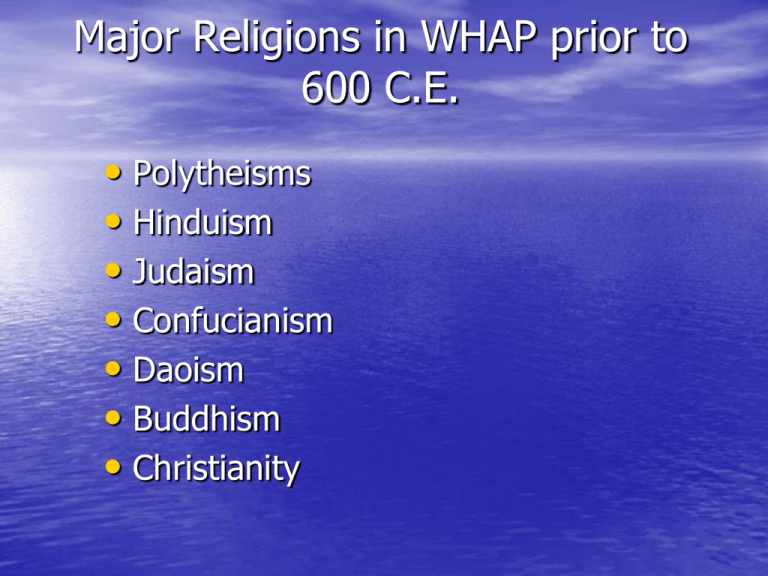
Major Religions in WHAP prior to 600 C.E. • Polytheisms • Hinduism • Judaism • Confucianism • Daoism • Buddhism • Christianity Polytheisms • “poly” means many; these religions worship • • • multiple gods Examples: Egypt, Mesopotamia, Shang, Mesoamerica, Greece, Rome Similarities: many of these polytheisms focused on appeasing the gods through rituals, obedience to a priestly class, sacrifices (human and/or animal) Differences: some gods were earth or agriculturally based (Mesopotamia, Greece), others were king based (Egypt) Hinduism (“what the Indians do”) • Location: began in the Indus Valley region (has origins in • • • Vedic religion of those people) and is mostly found in India Sacred Text: the Vedas, Upanishads. Non sacred but important: Mahabharata and Bhagavad-Gita (epic story) Important leaders: none-the evolution of Hinduism from Vedic religions of the past is fuzzy in history Major beliefs: “Hinduism is not a homogeneous, organized system. Many Hindus are devoted followers of Shiva or Vishnu, whom they regard as the only true God, while others look inward to the divine Self (atman). But most recognize the existence of Brahman, the unifying principle and Supreme Reality behind all that is.” Hinduism (“what the Indians do”) • Major Beliefs cont’d: words to know: – Dharma: fulfill religious, moral, social duties – Karma: deeds in a particular cycle of life – Atman: “breath” or soul, reborn in another body after death, based on previous life’s karma “You are where you deserve to be.” – Caste system: Brahmin (priests), Kshatriya (warriors & officials), Vaishya (merchants, artisans, landowners), Shudra (peasants, laborers), Untouchables (nastiest jobs) Hinduism (“what the Indians do”) • Deities: There is some debate on whether or not Hinduism is polytheistic. In once sense it is monotheistic because all gods are connected to Brahman or Ultimate Reality. – The Vedas are full of mythologies concerning many deities (Shiva and Vishnu most popular) that are worshipped largely based on regional preferences • Afterlife?: Hindus believe in reincarnation that never ends, but some branched out to believe in “moksha” or liberation, which was a release from the cycle of reincarnation. Judaism • Location: the crossroads of Anatolia, Egypt, • • Arabia, and Mesopotamia. Modern day Israel is the Jewish nation (with complications.) The Diaspora, or scattering, caused Jews to live all over the world; a large concentration live in Eastern Europe. Sacred Text: Hebrew Bible (The Christian Old Testament) (Torah is first 5 books) Important Leaders: Abraham, Isaac, Jacob, Moses, King David (transferred Israel to a monarchy), King Solomon (built the First Temple in Jerusalem) Judaism • Major Beliefs: There is one God (Yahweh) and the 10 Commandments (part of a larger book of the law containing over 600 laws) say to worship him only, making them God’s Chosen People by covenant. God led them from captivity in Egypt (using Moses) and through the desert for 40 years, a wandering ending in the Promised Land of Canaan (modern Israel and Palestinian territories). – Concerned with the coming of the Messiah who will save the Jewish people • Deity: God, called Yahweh, meaning “I Am.” • Afterlife?: Jews do not emphasize this, but some do believe in an afterlife like heaven. Confucianism • Location: founded in China, mostly confined to China today • Sacred Text: Analects (the sayings of Confucius, probably written by followers) • Important leader: Confucius • Deity: None. He did talk about Heaven, which was “a positive and personal force in the universe” but not a god • Afterlife? Not addressed. Confucianism • Major Beliefs: purpose in life is to fulfill role in society (hierarchy) with honesty, propriety, loyalty to family & nation. – Optimistic religion that says people can be guided to the right path through education, good role models, and self-improvement – Women should not participate in public life – Absolute authority rests with the father, the intermediary between the living and their ancestors – Practices involve following Chinese religions (important in ancestor worship), or even Buddhism Daoism (may be spelled Taoism) • Location: China during the Warring States Period, also southeast Asia • Sacred Text: Tao Te Ching, a small tract • Important Leader: Laozi • Deity: polytheistic Chinese religion, Daoism can also be purely philosophical • Afterlife?: try to revert back to a state of non-being, which is the other side of being Daoism (may be spelled Taoism) • Major Beliefs: Urges people to accept the world as they find it, avoid violence and struggle, adhere to the path (Dao) of nature. – An alternative to Confucius’s strict hierarchy, it idealizes finding your own path to righteousness – Yin and yang, the complementary nature of female and male roles in the natural world Buddhism • Location: began in India, spread through South Asia into • • • • East Asia Sacred Text: Tripitaka (collection of Buddha’s teachings) Important Leader: Siddhartha Guatama (The Buddha, or “Enlightened One”. He was a princely Hindu who decided to wander until he gained spiritual insight. Under a lotus tree he is said to have learned The Four Noble Truths then preached his first sermon, beginning the “Wheel of the Law” Deities: Buddhism doesn’t reject gods, but says they are unhelpful in finding enlightenment. Mahayana Buddhism is considered polytheistic, Theraveda Buddhism is atheistic Afterlife?: Reincarnation until enlightenment (nirvana) is achieved, which is a state of permanent tranquility (no suffering) Buddhism • Major Beliefs: The true nature of reality is the Four Noble Truths: 1) 2) 3) 4) • Life is suffering Suffering comes from your desires The solution to suffering is curbing desires Desire can be curbed if you follow the Eightfold Path: right views, aspirations, speech, conduct, livelihood, effort, mindfulness, and meditation Buddhism split into two parts: Mahayana and Theraveda. Mahayana is “Great Vehicle” Buddhism, or accessible to the masses. Theraveda is the “Teachings of the Elders” or the most original of Buddha’s teachings. Christianity • Location: modern day Israel; Rome ruled the area and • • • • came in conflict with the monotheism of Judaism (the caesar should be worshipped, not just God) Sacred Text: The Bible, which includes the Hebrew Bible plus the New Testament, a collection of Jesus’ teachings and writing by his followers Important leaders: Jesus, Paul Deity: God, who has three parts: Father, Son (Jesus), Holy Spirit Afterlife?: Heaven or hell. Heaven for those who claim Jesus as their savior, hell for those who do not. Christianity • Major Beliefs: All have sinned and are thereby separated from God. Salvation is through faith in Christ and, for some denominations, sacraments and good works. – There is a wide range of beliefs beyond this depending on denomination. – Remember: Under the title Christianity come both Catholicism and Protestantism!
